snow chains TOYOTA GR86 2022 Owners Manual (in English)
[x] Cancel search | Manufacturer: TOYOTA, Model Year: 2022, Model line: GR86, Model: TOYOTA GR86 2022Pages: 582, PDF Size: 86.38 MB
Page 168 of 582
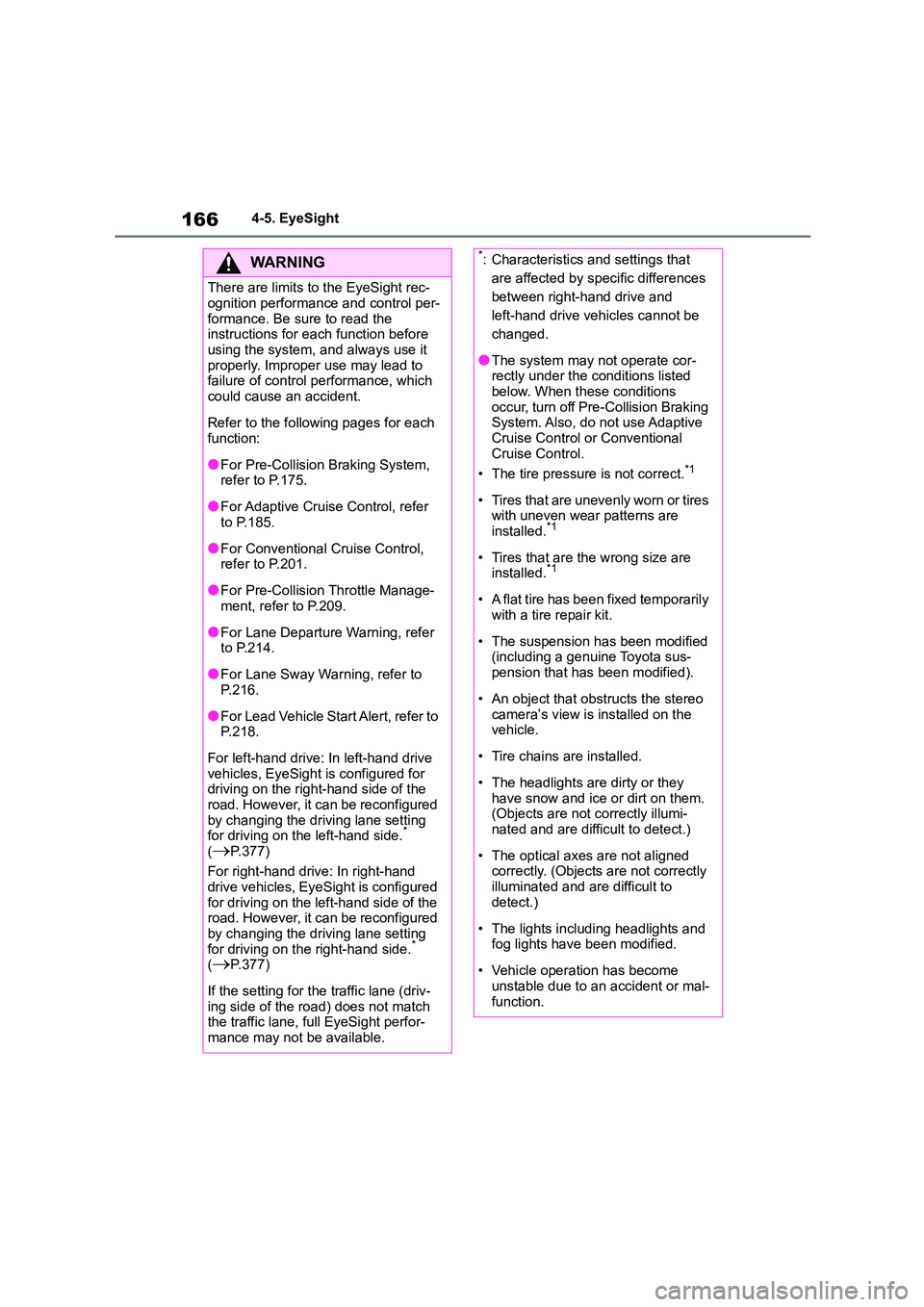
1664-5. EyeSight
WA R N I N G
There are limits to the EyeSight rec-
ognition performance and control per-
formance. Be sure to read the instructions for each function before
using the system, and always use it
properly. Improper use may lead to failure of control performance, which
could cause an accident.
Refer to the following pages for each function:
●For Pre-Collision Braking System, refer to P.175.
●For Adaptive Cruise Control, refer to P.185.
●For Conventional Cruise Control, refer to P.201.
●For Pre-Collision Throttle Manage-ment, refer to P.209.
●For Lane Departure Warning, refer to P.214.
●For Lane Sway Warning, refer to P.216.
●For Lead Vehicle Start Alert, refer to P.218.
For left-hand drive: In left-hand drive vehicles, EyeSight is configured for
driving on the right-hand side of the
road. However, it can be reconfigured by changing the driving lane setting
for driving on the left-hand side.*
(P.377)
For right-hand drive: In right-hand
drive vehicles, EyeSight is configured
for driving on the left-hand side of the road. However, it can be reconfigured
by changing the driving lane setting
for driving on the right-hand side.* (P.377)
If the setting for the traffic lane (driv- ing side of the road) does not match
the traffic lane, full EyeSight perfor-
mance may not be available.
*: Characteristics and settings that
are affected by specific differences
between right-hand drive and
left-hand drive vehicles cannot be
changed.
●The system may not operate cor-
rectly under the conditions listed below. When these conditions
occur, turn off Pre-Collision Braking
System. Also, do not use Adaptive Cruise Control or Conventional
Cruise Control.
• The tire pressure is not correct.*1
• Tires that are unevenly worn or tires
with uneven wear patterns are installed.*1
• Tires that are the wrong size are installed.*1
• A flat tire has been fixed temporarily with a tire repair kit.
• The suspension has been modified (including a genuine Toyota sus-
pension that has been modified).
• An object that obstructs the stereo
camera’s view is installed on the
vehicle.
• Tire chains are installed.
• The headlights are dirty or they
have snow and ice or dirt on them.
(Objects are not correctly illumi- nated and are difficult to detect.)
• The optical axes are not aligned correctly. (Objects are not correctly
illuminated and are difficult to
detect.)
• The lights including headlights and
fog lights have been modified.
• Vehicle operation has become
unstable due to an accident or mal-
function.
Page 180 of 582
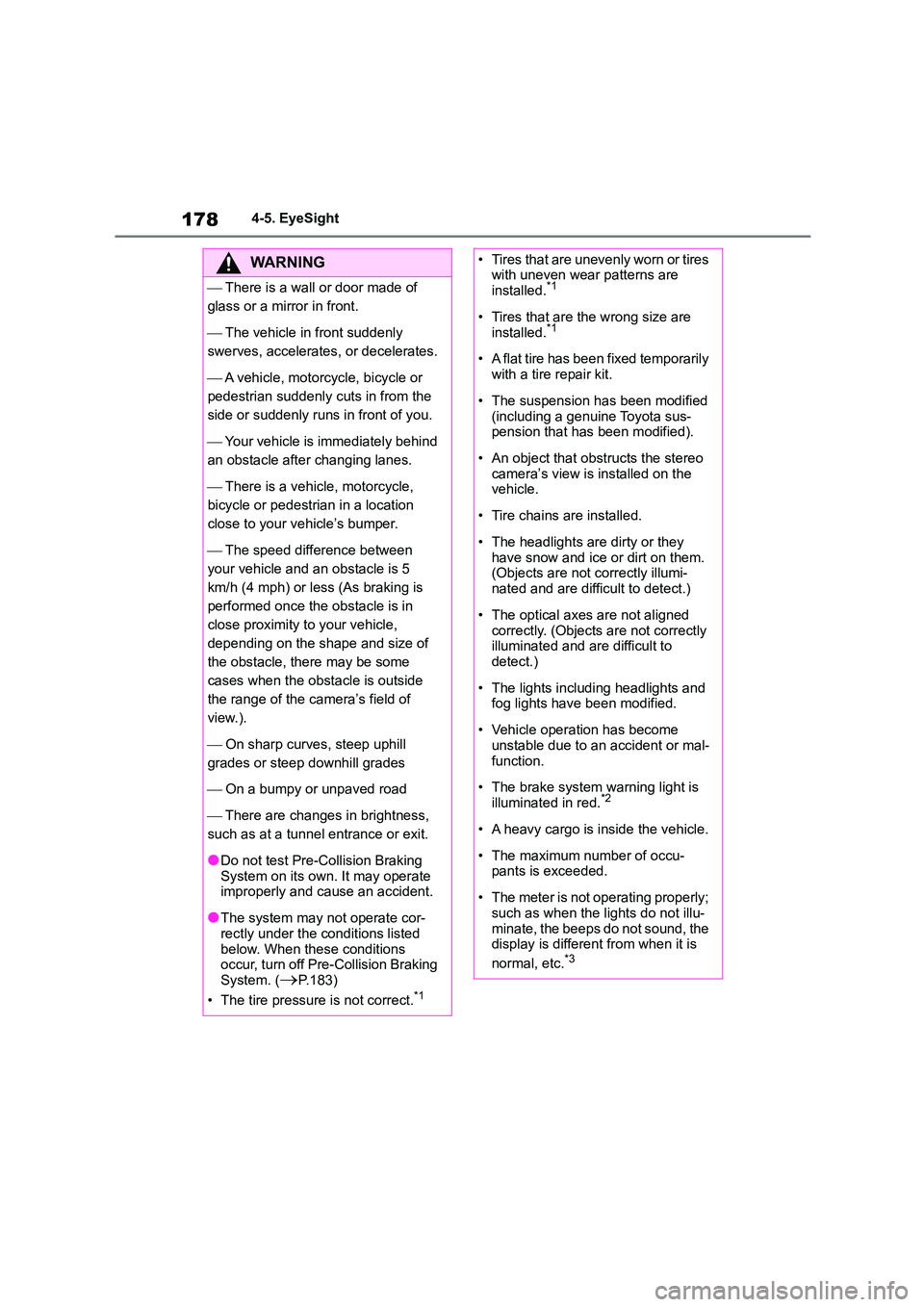
1784-5. EyeSight
WA R N I N G
There is a wall or door made of
glass or a mirror in front.
The vehicle in front suddenly
swerves, accelerates, or decelerates.
A vehicle, motorcycle, bicycle or
pedestrian suddenly cuts in from the
side or suddenly runs in front of you.
Your vehicle is immediately behind
an obstacle after changing lanes.
There is a vehicle, motorcycle,
bicycle or pedestri an in a location
close to your vehicle’s bumper.
The speed difference between
your vehicle and an obstacle is 5
km/h (4 mph) or less (As braking is
performed once the obstacle is in
close proximity to your vehicle,
depending on the shape and size of
the obstacle, there may be some
cases when the obstacle is outside
the range of the camera’s field of
view.).
On sharp curves, steep uphill
grades or steep downhill grades
On a bumpy or unpaved road
There are changes in brightness,
such as at a tunnel entrance or exit.
●Do not test Pre-Collision Braking System on its own. It may operate
improperly and cause an accident.
●The system may not operate cor-
rectly under the conditions listed
below. When these conditions occur, turn off Pre-Collision Braking
System. (P.183)
• The tire pressure is not correct.*1
• Tires that are unevenly worn or tires with uneven wear patterns are
installed.*1
• Tires that are the wrong size are
installed.*1
• A flat tire has been fixed temporarily
with a tire repair kit.
• The suspension has been modified
(including a genuine Toyota sus-
pension that has been modified).
• An object that obstructs the stereo
camera’s view is installed on the vehicle.
• Tire chains are installed.
• The headlights are dirty or they
have snow and ice or dirt on them. (Objects are not correctly illumi-
nated and are difficult to detect.)
• The optical axes are not aligned
correctly. (Objects are not correctly
illuminated and are difficult to detect.)
• The lights including headlights and fog lights have been modified.
• Vehicle operation has become unstable due to an accident or mal-
function.
• The brake system warning light is
illuminated in red.*2
• A heavy cargo is inside the vehicle.
• The maximum number of occu- pants is exceeded.
• The meter is not operating properly; such as when the lights do not illu-
minate, the beeps do not sound, the
display is different from when it is
normal, etc.*3
Page 188 of 582
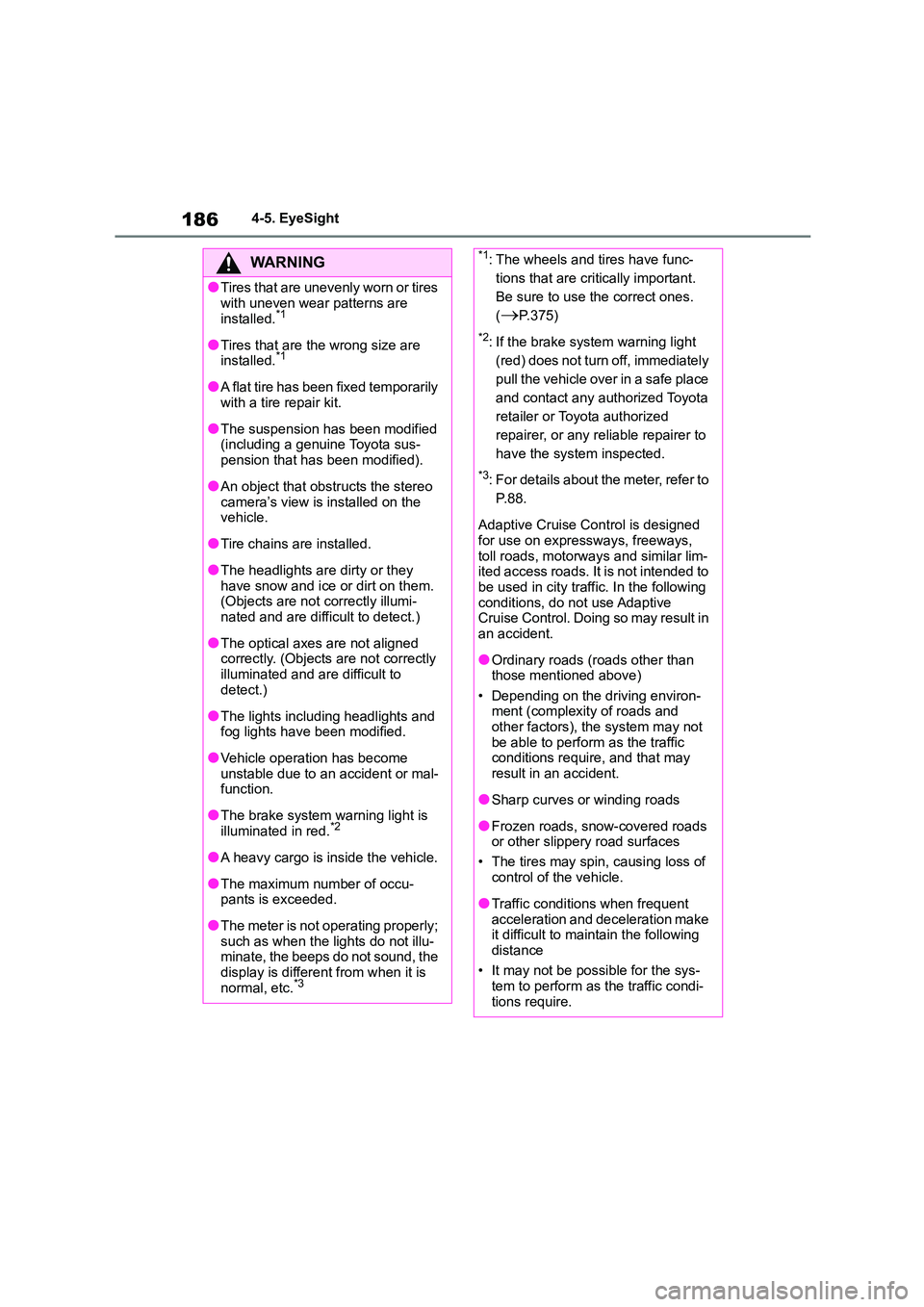
1864-5. EyeSight
WA R N I N G
●Tires that are unevenly worn or tires
with uneven wear patterns are
installed.*1
●Tires that are the wrong size are
installed.*1
●A flat tire has been fixed temporarily
with a tire repair kit.
●The suspension has been modified
(including a genuine Toyota sus-
pension that has been modified).
●An object that ob structs the stereo
camera’s view is installed on the vehicle.
●Tire chains are installed.
●The headlights are dirty or they
have snow and ice or dirt on them. (Objects are not correctly illumi-
nated and are difficult to detect.)
●The optical axes are not aligned
correctly. (Objects are not correctly
illuminated and are difficult to detect.)
●The lights including headlights and fog lights have been modified.
●Vehicle operation has become unstable due to an accident or mal-
function.
●The brake system warning light is
illuminated in red.*2
●A heavy cargo is inside the vehicle.
●The maximum num ber of occu- pants is exceeded.
●The meter is not operating properly; such as when the lights do not illu-
minate, the beeps do not sound, the
display is different from when it is normal, etc.*3
*1: The wheels and tires have func-
tions that are critically important.
Be sure to use the correct ones.
(P.375)
*2: If the brake system warning light
(red) does not turn off, immediately
pull the vehicle over in a safe place
and contact any authorized Toyota
retailer or Toyota authorized
repairer, or any reliable repairer to
have the system inspected.
*3: For details about the meter, refer to
P.88.
Adaptive Cruise Control is designed for use on expressways, freeways,
toll roads, motorways and similar lim-
ited access roads. It is not intended to be used in city traffic. In the following
conditions, do not use Adaptive
Cruise Control. Doin g so may result in an accident.
●Ordinary roads (roads other than those mentioned above)
• Depending on the driving environ-
ment (complexity of roads and other factors), the system may not
be able to perform as the traffic
conditions require, and that may result in an accident.
●Sharp curves or winding roads
●Frozen roads, snow-covered roads
or other slippery road surfaces
• The tires may spin, causing loss of
control of the vehicle.
●Traffic conditions when frequent
acceleration and deceleration make
it difficult to maintain the following
distance
• It may not be possible for the sys-
tem to perform as the traffic condi-
tions require.
Page 240 of 582
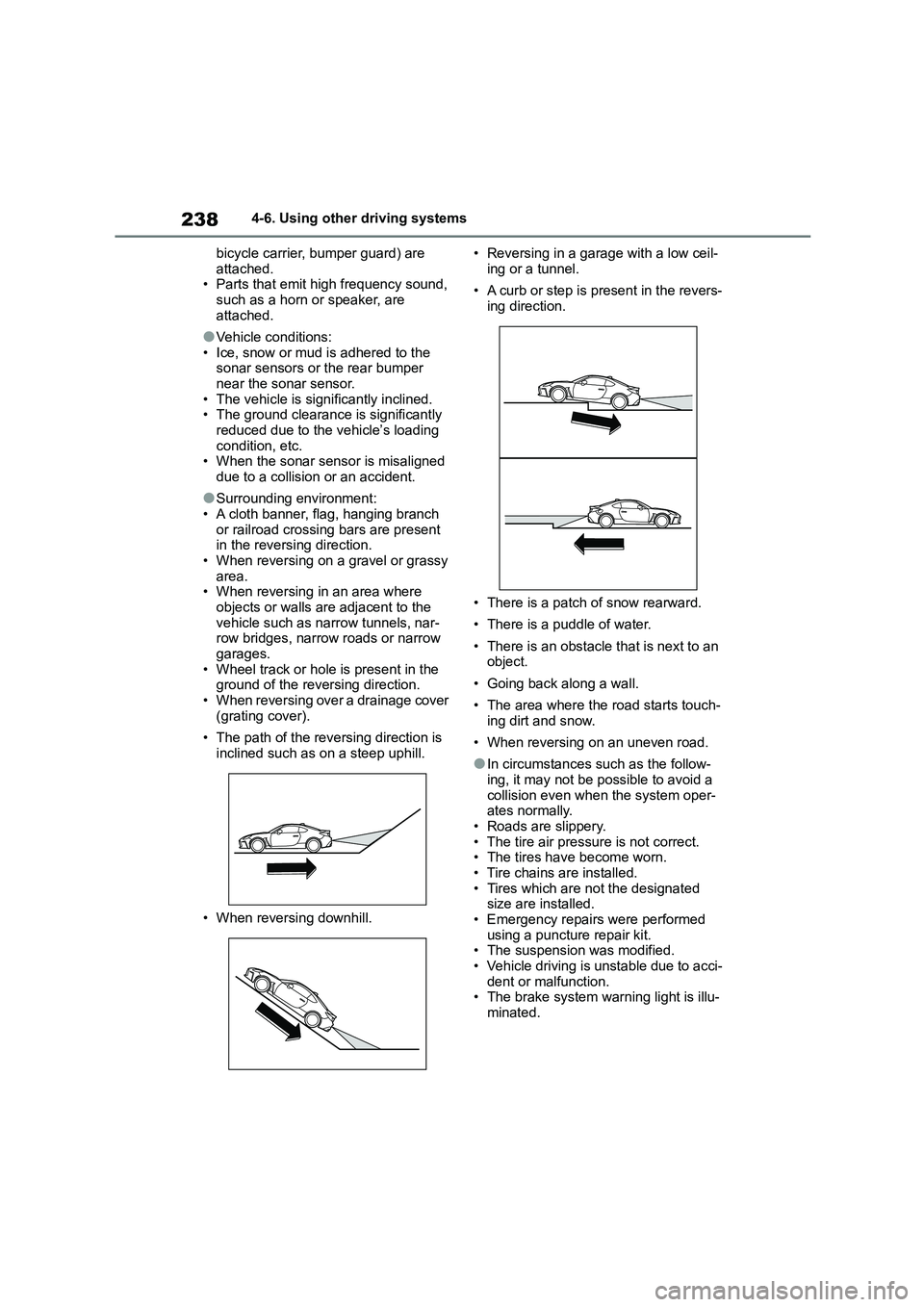
2384-6. Using other driving systems
bicycle carrier, bumper guard) are
attached. • Parts that emit high frequency sound,
such as a horn or speaker, are
attached.
●Vehicle conditions:
• Ice, snow or mud is adhered to the sonar sensors or the rear bumper
near the sonar sensor.
• The vehicle is significantly inclined. • The ground clearance is significantly
reduced due to the vehicle’s loading
condition, etc. • When the sonar sensor is misaligned
due to a collision or an accident.
●Surrounding environment:
• A cloth banner, flag, hanging branch
or railroad crossing bars are present in the reversing direction.
• When reversing on a gravel or grassy
area. • When reversing in an area where
objects or walls are adjacent to the
vehicle such as narrow tunnels, nar- row bridges, narrow roads or narrow
garages.
• Wheel track or hole is present in the ground of the reversing direction.
• When reversing over a drainage cover
(grating cover).
• The path of the reversing direction is
inclined such as on a steep uphill.
• When reversing downhill.
• Reversing in a garage with a low ceil-
ing or a tunnel.
• A curb or step is present in the revers-
ing direction.
• There is a patch of snow rearward.
• There is a puddle of water.
• There is an obstacle that is next to an
object.
• Going back along a wall.
• The area where the road starts touch-
ing dirt and snow.
• When reversing on an uneven road.
●In circumstances su ch as the follow- ing, it may not be possible to avoid a
collision even when the system oper-
ates normally. • Roads are slippery.
• The tire air pressure is not correct.
• The tires have become worn. • Tire chains are installed.
• Tires which are not the designated
size are installed. • Emergency repairs were performed
using a puncture repair kit.
• The suspension was modified. • Vehicle driving is unstable due to acci-
dent or malfunction.
• The brake system warn ing light is illu-
minated.
Page 261 of 582
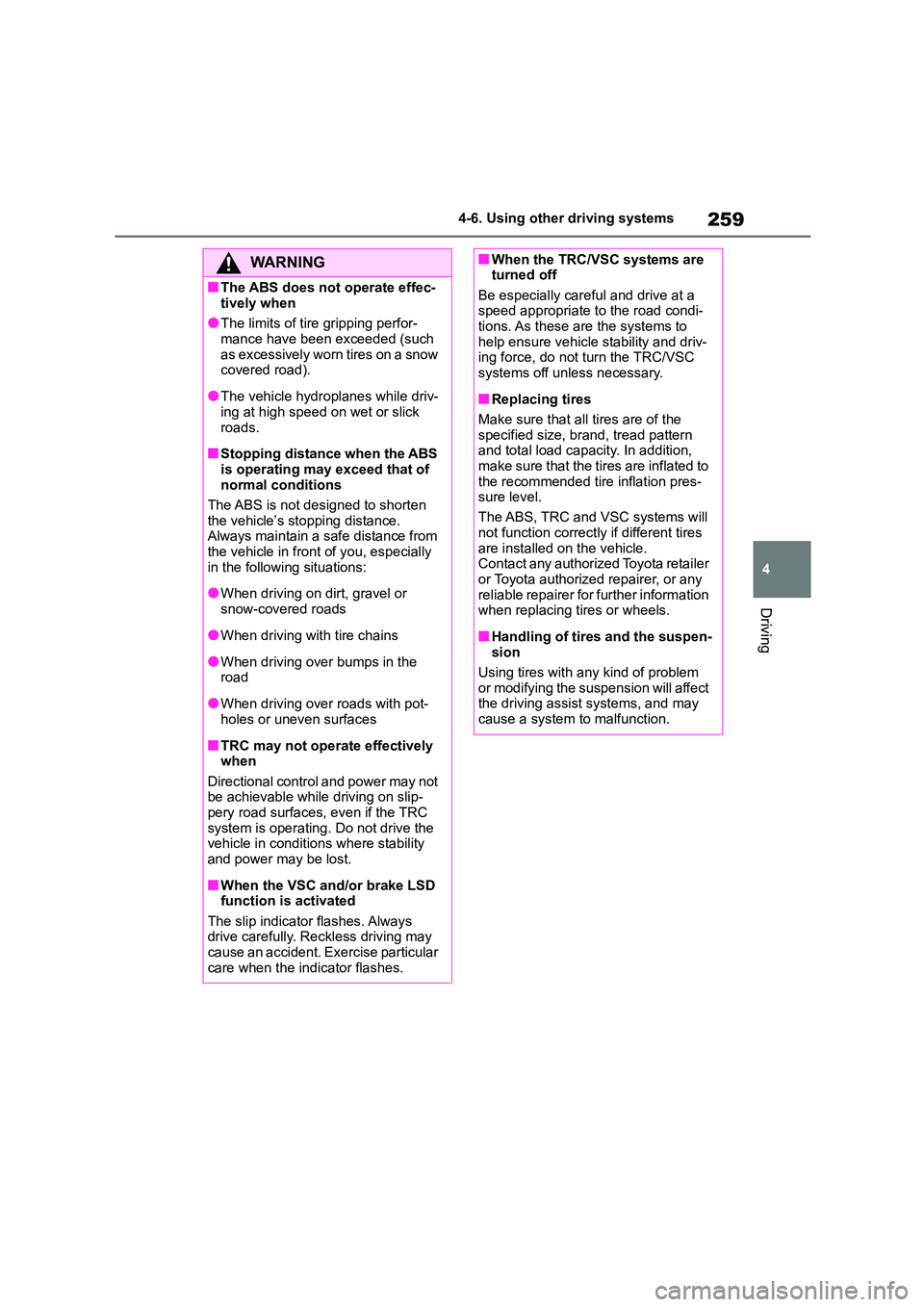
259
4
4-6. Using other driving systems
Driving
WA R N I N G
■The ABS does not operate effec-
tively when
●The limits of tire gripping perfor- mance have been exceeded (such
as excessively worn tires on a snow
covered road).
●The vehicle hydroplanes while driv-
ing at high speed on wet or slick
roads.
■Stopping distance when the ABS
is operating may exceed that of normal conditions
The ABS is not designed to shorten
the vehicle’s stopping distance. Always maintain a safe distance from
the vehicle in front of you, especially
in the following situations:
●When driving on dirt, gravel or
snow-covered roads
●When driving with tire chains
●When driving over bumps in the
road
●When driving over roads with pot-
holes or uneven surfaces
■TRC may not operate effectively
when
Directional control and power may not be achievable while driving on slip-
pery road surfaces, even if the TRC
system is operating. Do not drive the vehicle in conditions where stability
and power may be lost.
■When the VSC and/or brake LSD
function is activated
The slip indicator flashes. Always drive carefully. Reckless driving may
cause an accident. Exercise particular
care when the indicator flashes.
■When the TRC/VSC systems are turned off
Be especially careful and drive at a
speed appropriate to the road condi- tions. As these are the systems to
help ensure vehicle stability and driv-
ing force, do not turn the TRC/VSC systems off unless necessary.
■Replacing tires
Make sure that all tires are of the
specified size, brand, tread pattern
and total load capacity. In addition, make sure that the tires are inflated to
the recommended tire inflation pres-
sure level.
The ABS, TRC and VSC systems will
not function correctly if different tires
are installed on the vehicle. Contact any authorized Toyota retailer
or Toyota authorized repairer, or any
reliable repairer for further information when replacing tires or wheels.
■Handling of tires and the suspen-sion
Using tires with any kind of problem
or modifying the suspension will affect the driving assist systems, and may
cause a system to malfunction.
Page 262 of 582

2604-7. Driving tips
4-7.Driving tips
Use fluids that are appropriate to
the prevailing out side tempera-
tures.
• Engine oil
• Engine coolant
• Washer fluid
Have a service technician
inspect the condition of the bat-
tery.
Have the vehicle fitted with four
snow tires or purchase a set of
tire chains for the rear tires.
Make sure to install 4 tires that are of
the specified size, and that all 4 tires
are the same size, same maker, same
brand and tread pattern. Also, make
sure to use tire chains that match the
size of the tires.
Winter driving tips
Carry out the necessary prepa-
rations and inspections before
driving the vehicle in winter.
Always drive the vehicle in a
manner appropriate to the pre-
vailing weather conditions.
Preparation for winter
WA R N I N G
■Driving with snow tires
Observe the following precautions to
reduce the risk of accidents.
Failure to do so may result in a loss of vehicle control and cause death or
serious injury.
●Use tires of the specified size, and that are the same size, same
maker, same brand and tread pat-
tern.
●Maintain the recommended level of
air pressure.
●Do not drive at speeds in excess of
the speed limit or the speed limit specified for the snow tires being
used.
●Use snow tires on a ll, not just some
wheels.
■Driving with tire chains
●When any of the tires are punc-
tured, you can seal the tire tempo- rarily. However, do not use the tire
chain on a sealed tire. If any of the
rear tires are punctured although it is required to use tire chains, con-
tact any authorized Toyota dealer or
repairer, or another duly qualified and equipped professional.
●Observe the following precautions to reduce the risk of accidents.
Failure to do so may result in the
vehicle being unable to be driven safely, and may cause death or
serious injury.
• Do not drive in excess of the speed limit specified for the tire chains
being used, or 30 km/h (19 mph),
whichever is lower.
• Avoid driving on bumpy road sur-
faces or over potholes.
• Avoid sudden acceleration, abrupt
steering, sudden braking and shift- ing operations that cause sudden
engine braking.
• Slow down sufficiently before enter- ing a curve to ensure that vehicle
control is maintained.
Page 263 of 582
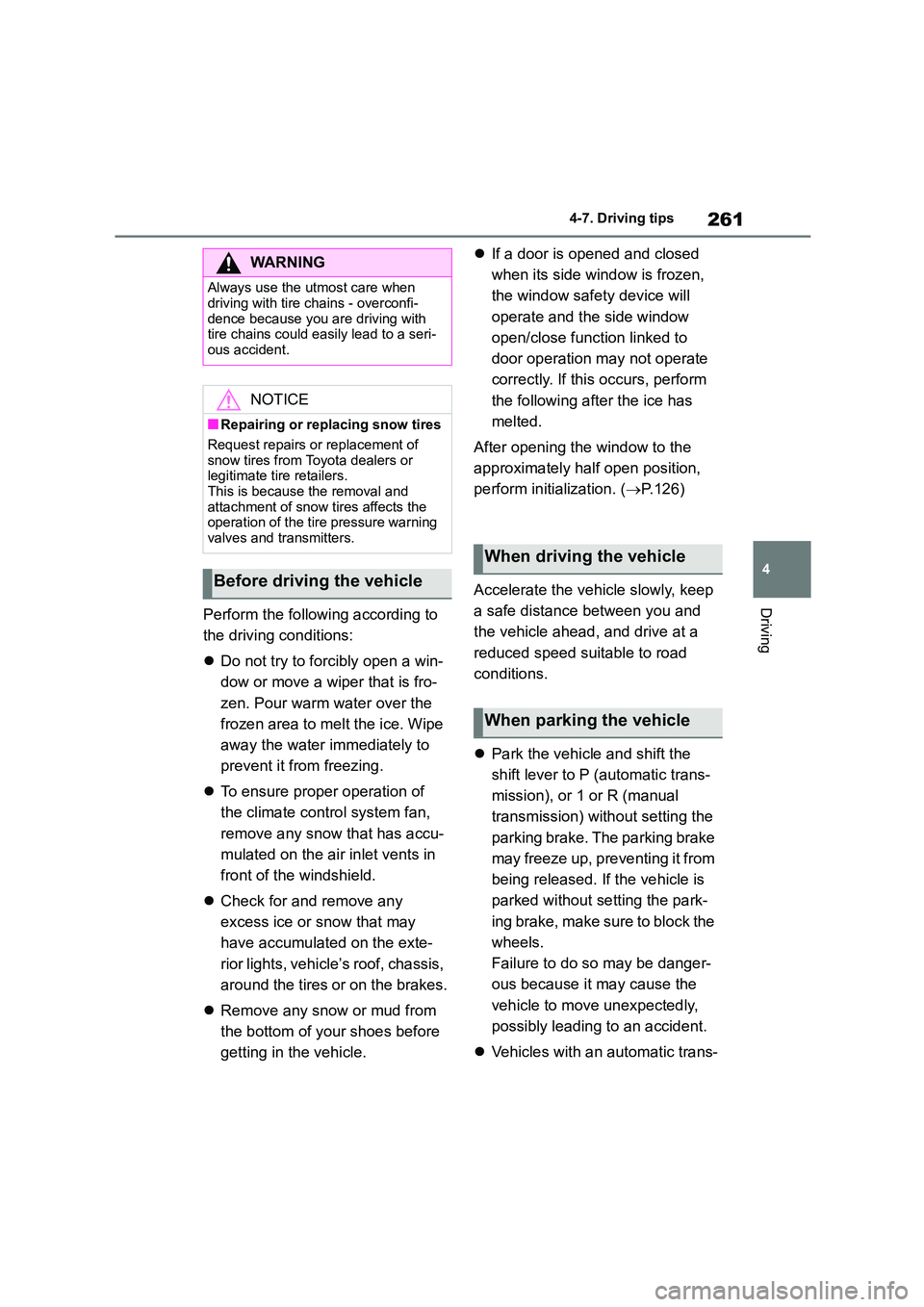
261
4
4-7. Driving tips
DrivingPerform the following according to
the driving conditions:
Do not try to forcibly open a win-
dow or move a wiper that is fro-
zen. Pour warm water over the
frozen area to melt the ice. Wipe
away the water immediately to
prevent it from freezing.
To ensure proper operation of
the climate control system fan,
remove any snow that has accu-
mulated on the air inlet vents in
front of the windshield.
Check for and remove any
excess ice or snow that may
have accumulated on the exte-
rior lights, vehicle’s roof, chassis,
around the tires or on the brakes.
Remove any snow or mud from
the bottom of your shoes before
getting in the vehicle.
If a door is opened and closed
when its side window is frozen,
the window safety device will
operate and the side window
open/close function linked to
door operation may not operate
correctly. If this occurs, perform
the following after the ice has
melted.
After opening the window to the
approximately half open position,
perform initialization. ( P.126)
Accelerate the vehicle slowly, keep
a safe distance between you and
the vehicle ahead, and drive at a
reduced speed suitable to road
conditions.
Park the vehicle and shift the
shift lever to P (automatic trans-
mission), or 1 or R (manual
transmission) with out setting the
parking brake. The parking brake
may freeze up, preventing it from
being released. If the vehicle is
parked without setting the park-
ing brake, make sure to block the
wheels.
Failure to do so may be danger-
ous because it may cause the
vehicle to move unexpectedly,
possibly leading to an accident.
Vehicles with an automatic trans-
WA R N I N G
Always use the utmost care when
driving with tire chains - overconfi-
dence because you are driving with tire chains could easily lead to a seri-
ous accident.
NOTICE
■Repairing or replacing snow tires
Request repairs or replacement of snow tires from Toyota dealers or
legitimate tire retailers.
This is because the removal and attachment of snow tires affects the
operation of the tire pressure warning
valves and transmitters.
Before driving the vehicle
When driving the vehicle
When parking the vehicle
Page 304 of 582
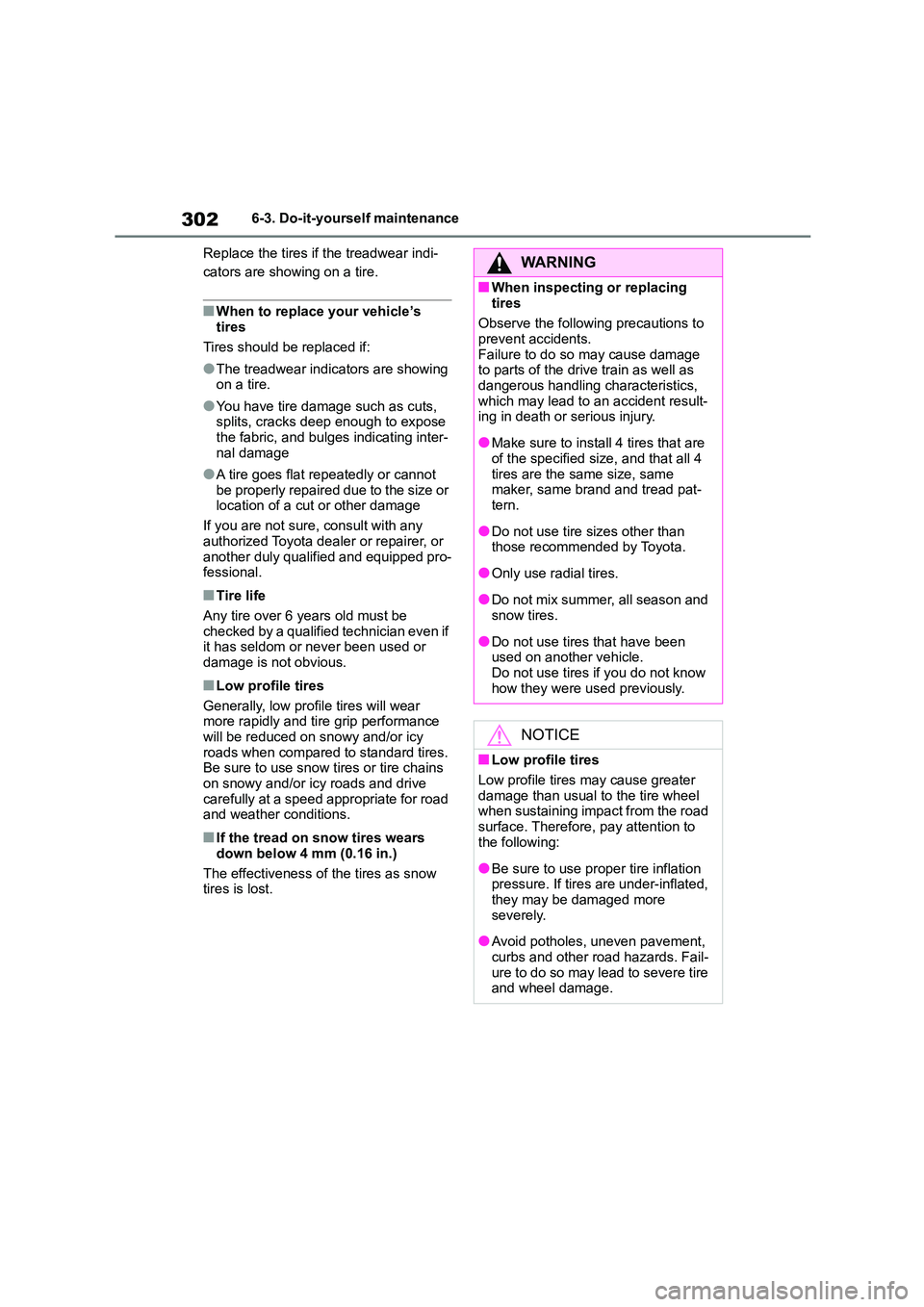
3026-3. Do-it-yourself maintenance
Replace the tires if the treadwear indi-
cators are showing on a tire.
■When to replace your vehicle’s
tires
Tires should be replaced if:
●The treadwear indicators are showing on a tire.
●You have tire damage such as cuts, splits, cracks deep enough to expose
the fabric, and bulges indicating inter-
nal damage
●A tire goes flat repeatedly or cannot
be properly repaired due to the size or location of a cut or other damage
If you are not sure, consult with any
authorized Toyota dealer or repairer, or another duly qualified and equipped pro-
fessional.
■Tire life
Any tire over 6 years old must be checked by a qualified technician even if
it has seldom or never been used or
damage is not obvious.
■Low profile tires
Generally, low profile tires will wear
more rapidly and tire grip performance
will be reduced on snowy and/or icy roads when compared to standard tires.
Be sure to use snow tires or tire chains
on snowy and/or icy roads and drive
carefully at a speed appropriate for road and weather conditions.
■If the tread on snow tires wears
down below 4 mm (0.16 in.)
The effectiveness of the tires as snow tires is lost.
WA R N I N G
■When inspecting or replacing
tires
Observe the following precautions to prevent accidents.
Failure to do so may cause damage
to parts of the drive train as well as dangerous handling characteristics,
which may lead to an accident result-
ing in death or serious injury.
●Make sure to insta ll 4 tires that are
of the specified size, and that all 4
tires are the same size, same maker, same brand and tread pat-
tern.
●Do not use tire sizes other than
those recommended by Toyota.
●Only use radial tires.
●Do not mix summer, all season and snow tires.
●Do not use tires that have been used on another vehicle.
Do not use tires if you do not know
how they were used previously.
NOTICE
■Low profile tires
Low profile tires may cause greater
damage than usual to the tire wheel when sustaining impact from the road
surface. Therefore, pay attention to
the following:
●Be sure to use proper tire inflation
pressure. If tires are under-inflated, they may be damaged more
severely.
●Avoid potholes, uneven pavement,
curbs and other road hazards. Fail-
ure to do so may lead to severe tire and wheel damage.
Page 306 of 582

3046-3. Do-it-yourself maintenance
pressure has been adjusted.
●Tire inflation pressure changes with
temperature. The displayed values
may also be different from the values measured using a tire pressure
gauge.
■Situations in which the tire pres-
sure warning system may not oper- ate properly
●In the following cases, the tire pres-sure warning system may not operate
properly.
• If non-genuine Toyota wheels are used.
• A tire has been replaced with a tire
that is not an OE (Original Equipment) tire.
• A tire has been replaced with a tire
that is not of the specified size. • Tire chains, etc. are equipped.
• An auxiliary-supported run-flat tire is
equipped. • If a window tint that affects the radio
wave signals is installed.
• If there is a lot of snow or ice on the vehicle, particularly around the wheels
or wheel housings.
• If the tire inflation pressure is extremely higher than the specified
level.
• If tires not equipped with tire pressure warning valves and transmitters are
used.
• If the ID code on the tire pressure warning valves and transmitters is not
registered in the tire pressure warning
computer.
●Performance may be affected in the
following situations. • When driving near a TV tower, electric
power plant, gas station, radio station,
large display, airport or other facility
that generates strong radio waves or electrical noise
• When carrying a portable radio, cellu-
lar phone, cordless phone or other wireless communication device
If tire position information is not correctly
displayed due to the radio wave condi- tions, the display ma y be corrected by
driving and changing the radio wave
conditions.
●When the vehicle is parked, the time
taken for the warning to start or go off
could be extended.
●When tire inflation pressure declines
rapidly for example when a tire has burst, the warning may not function.
■Warning performance of the tire
pressure warning system
The warning of the tire pressure warning system will change in accordance with
driving conditions. For this reason, the
system may give a warning even if the tire pressure does not reach a low
enough level, or if the pressure is higher
than the pressure that was adjusted to when the system was initialized.
When replacing tires or wheels, tire
pressure warning valves and trans-
mitters must also be installed.
When new tire pressure warning
valves and transmitters are
installed, new ID codes must be
registered in the tire pressure warn-
ing computer and the tire pressure
warning system must be initialized.
Have tire pressu re warning valve
and transmitter ID codes regis-
tered by any authorized Toyota
retailer or Toyota authorized
repairer, or any reliable repairer.
( P. 3 0 6 )
■Replacing tires and wheels
If the ID code of the tire pressure warn-
ing valve and transmitter is not regis- tered, the tire pressure warning system
will not work properly. After driving for
about 10 minutes, the tire pressure warning light blinks for 1 minute and
Installing tire pressure warn-
ing valves and transmitters
Page 398 of 582
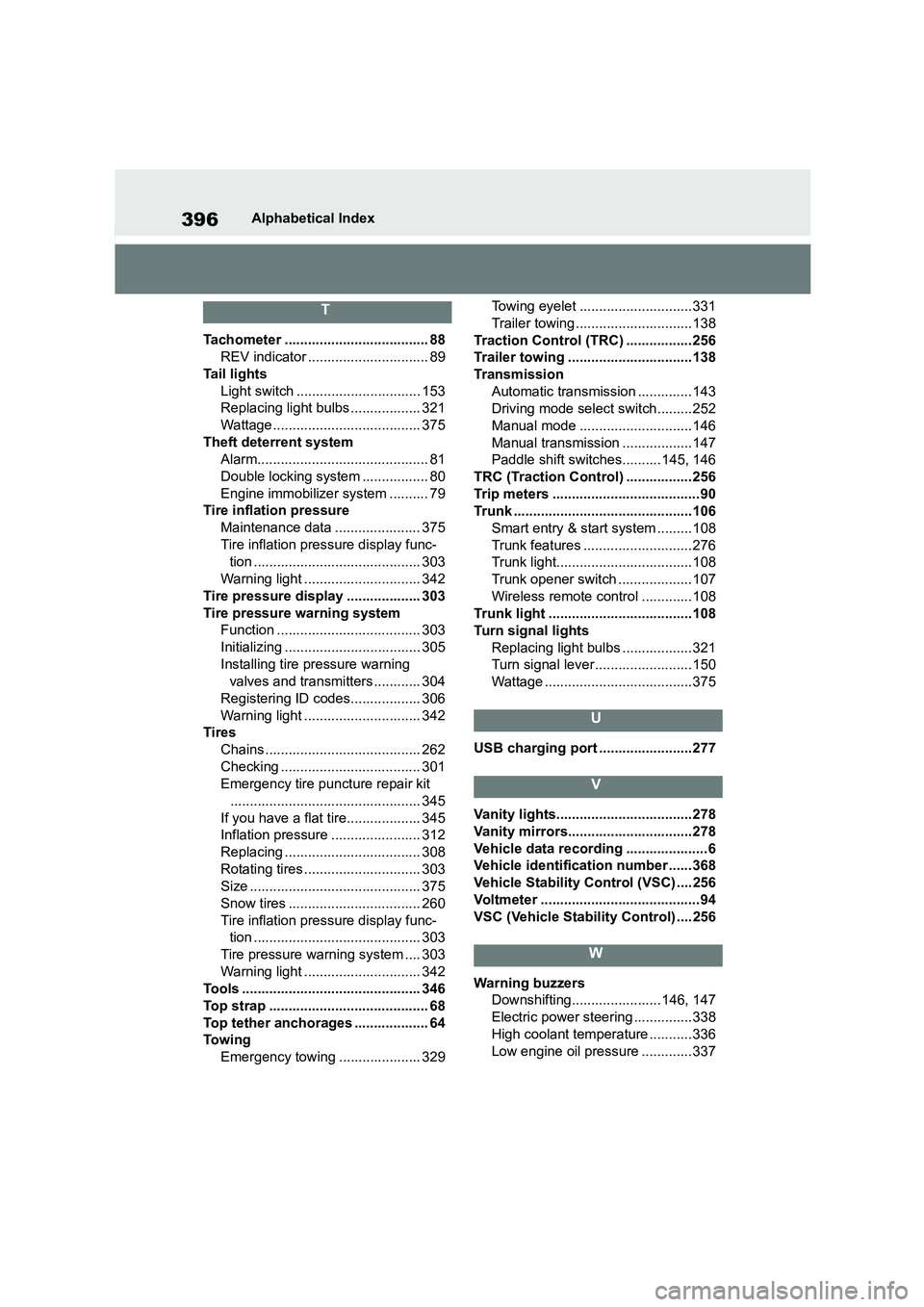
396Alphabetical Index
T
Tachometer ..................................... 88
REV indicator ............................... 89
Tail lights
Light switch ................................ 153
Replacing light bulbs .................. 321
Wattage...................................... 375
Theft deterrent system
Alarm............................................ 81
Double locking system ................. 80
Engine immobilize r system .......... 79
Tire inflation pressure
Maintenance data ...................... 375
Tire inflation pre ssure display func-
tion ........................................... 303
Warning light .............................. 342
Tire pressure display ................... 303
Tire pressure warning system
Function ..................................... 303
Initializing ................................... 305
Installing tire pressure warning
valves and transmitters ............ 304
Registering ID codes.................. 306
Warning light .............................. 342
Tires
Chains ........................................ 262
Checking .................................... 301
Emergency tire puncture repair kit
................................................. 345
If you have a flat tire................... 345
Inflation pressure ....................... 312
Replacing ................................... 308
Rotating tires .............................. 303
Size ............................................ 375
Snow tires .................................. 260
Tire inflation pre ssure display func-
tion ........................................... 303
Tire pressure wa rning system .... 303
Warning light .............................. 342
Tools .............................................. 346
Top strap ......................................... 68
Top tether anchorages ................... 64
To w i n g
Emergency towing ..................... 329
Towing eyelet .............................331
Trailer towing ..............................138
Traction Control (TRC) ................. 256
Trailer towing ................................138
Transmission
Automatic transmission .............. 143
Driving mode select switch.........252
Manual mode .............................146
Manual transmission ..................147
Paddle shift switches..........145, 146
TRC (Traction Control) ................. 256
Trip meters ...................................... 90
Trunk ..............................................106
Smart entry & start system .........108
Trunk features ............................ 276
Trunk light...................................108
Trunk opener switch ................... 107
Wireless remote control .............108
Trunk light .....................................108
Turn signal lights
Replacing light bulbs ..................321
Turn signal lever ......................... 150
Wattage ......................................375
U
USB charging port ........................277
V
Vanity lights...................................278
Vanity mirrors................................278
Vehicle data recording ..................... 6
Vehicle identification number ...... 368
Vehicle Stability Control (VSC) ....256
Voltmeter ......................................... 94
VSC (Vehicle Stability Control) ....256
W
Warning buzzers
Downshifting....................... 146, 147
Electric power steering ...............338
High coolant temperature ........... 336
Low engine oil pressure ............. 337